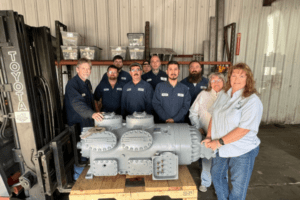Managing a commercial HVAC system over its lifecycle involves a proactive approach to maintenance, repairs, and eventual replacement. Each stage of your system’s life presents specific challenges and opportunities to maximize efficiency, reduce downtime, and ensure a comfortable environment for clients, customers, and employees. Here’s a look at what HVAC/R technicians should monitor throughout the life of a commercial HVAC system to keep it functioning at peak performance.
1. Regular Maintenance is Key
Consistent maintenance is crucial for extending the life of a commercial HVAC system. Scheduled inspections, cleaning, and timely repairs can prevent minor issues from escalating into major problems that shorten the system’s lifespan. Filters should be checked and replaced regularly to prevent airflow restrictions that force the system to work harder than necessary. Proper cleaning of coils, lubricating moving parts, and ensuring all components are in good working order will keep the system efficient and lower the risk of unexpected breakdowns.
2. Monitor Usage Patterns
How often and intensely an HVAC system is used can directly affect its lifespan. Systems in buildings that operate 24/7, such as data centers, food warehouses, grocery stores, and hospitals, are more prone to wear and tear compared to systems used only during regular business hours. Constant operation increases the demand for compressors, motors, and other key components, causing faster degradation. Monitoring usage patterns can help technicians identify potential issues before they become critical, allowing for proactive adjustments to ensure longevity.
3. Quality of Installation Matters
A poorly installed HVAC system can face operational inefficiencies from the start, leading to higher energy costs, uneven heating or cooling, and accelerated wear. Technicians should assess the quality of the installation, looking for signs of improper setup that may be causing the system to work harder than necessary. Issues like improperly calibrated thermostats, misaligned ductwork, or inadequate insulation around components can all cause the system to underperform and experience premature wear. A solid installation not only maximizes system performance but also ensures that routine maintenance efforts have the desired impact.
4. Keep an Eye on Environmental Factors
The environment in which an HVAC system operates has a significant impact on its durability. Systems located in areas with high levels of dust, pollutants, or extreme temperatures—such as industrial or manufacturing facilities—are more susceptible to issues like filter clogs, coil corrosion, and overheating. HVAC technicians should assess these environmental factors and adjust maintenance schedules accordingly, performing more frequent cleanings or inspections when needed. Additionally, adding protective covers or upgrading system components may help mitigate damage caused by a harsh operating environment.
5. Watch for Performance Warning Signs
As the HVAC system ages, it’s essential to monitor for signs that indicate a decline in performance. Common indicators include increasing energy bills, inconsistent temperatures, frequent breakdowns, vibration of the compressor, and unusual noises such as grinding, banging, or squealing. These signs often point to underlying issues within the system—whether it’s a failing compressor, a worn blower motor, a power supply issue, or leaking refrigerant lines.
For example, a significant and unexplained rise in energy costs may indicate that the system is no longer operating efficiently, a clear signal that certain parts may need replacement. In healthcare facilities, where temperature control is critical, a system that struggles to maintain a stable environment could disrupt operations, emphasizing the importance of addressing these issues promptly.
6. Understand Which Parts Tend to Fail First
Knowing which components are most susceptible to wear and tear allows technicians to anticipate maintenance needs. Key parts that often fail first in commercial HVAC systems include:
- Compressors: Responsible for circulating refrigerant, compressors experience high demand and are prone to wear, which can impact the entire system.
- Evaporator and Condenser Coils: These coils corrode over time or become clogged with debris, which can lead to cooling issues or overheating.
- Blower Motors: Essential for airflow, blower motors can burn out from constant use.
- Capacitors: These provide the initial energy to start motors; failed capacitors may prevent the system from running.
- Filters and Thermostats: Dirty filters restrict airflow, while malfunctioning thermostats cause inaccurate temperature control, straining the system.
Technicians should prioritize these components during routine inspections to catch wear early and reduce the likelihood of unexpected failures.
7. Plan for Timely Replacement
Even with the best maintenance, every HVAC system will eventually reach the end of its useful life. Most commercial HVAC systems have a lifespan of 10 to 25 years, depending on usage, maintenance, and environmental factors. Technicians should keep track of system age and begin evaluating performance as it nears the 15- to 20-year mark. As the system shows signs of decline, planning for a replacement in advance can save costs and prevent disruptions.
When it’s time for replacement, technicians should consider options that align with the building’s current needs and energy goals, potentially upgrading to a more energy-efficient system that offers long-term savings.
8. Use Insights to Make Data-Driven Decisions
Modern HVAC systems often come equipped with sensors and data tracking capabilities that provide insights into performance. Technicians can use this data to monitor efficiency, identify potential issues, and optimize maintenance schedules. For instance, tracking energy consumption patterns may reveal inefficiencies or pinpoint when certain components are starting to fail. Data-driven maintenance helps extend the life of the HVAC system and reduces unexpected repair costs.
Final Commercial HVAC/R Thoughts
Proactive management of a commercial HVAC system over its lifecycle is essential for maintaining efficiency, reducing costs, and ensuring a comfortable environment for building occupants. By following a structured approach—prioritizing regular maintenance, monitoring environmental and operational factors, and planning ahead for replacement—HVAC technicians can maximize the value and longevity of these critical systems. Each stage in the life of an HVAC system presents unique opportunities for care, allowing technicians to optimize performance and deliver lasting benefits for commercial spaces.












